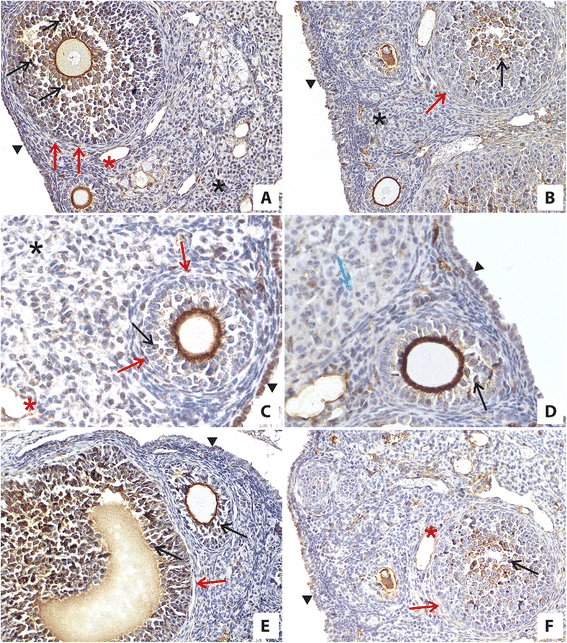Caloric restriction increases ratio of estrogen to androgen receptors expression in murine ovaries--potential therapeutic implications
- PMID: 26264910
- PMCID: PMC4534007
- DOI: 10.1186/s13048-015-0185-8
Caloric restriction increases ratio of estrogen to androgen receptors expression in murine ovaries--potential therapeutic implications
Abstract
Both estrogens and androgens are involved in the development and normal functioning of the ovaries. It is also known that ovarian function is regulated by diet. The goal of this study was to estimate the expression of sex hormone receptors in ovaries of mice that were on a 9-month caloric restriction (alternate-day feeding) as compared to normal control animals fed ad libitum. We found that prolonged caloric restriction in mouse ovaries led to increased expression of estrogen receptors (ERs) but did not affect expression of the androgen receptor (AR). This increase in ER:AR ration as result of caloric restriction may lead to higher sensitivity to estrogens and upon return to normal diet may increase ovulation. Thus our observation shed more light on a role of beneficial effect of calorie restriction on female reproduction.
Figures


Similar articles
-
Gene expression profiles revealing the mechanisms of anti-androgen- and estrogen-induced feminization in fish.Aquat Toxicol. 2007 Feb 28;81(2):219-31. doi: 10.1016/j.aquatox.2006.12.003. Epub 2006 Dec 17. Aquat Toxicol. 2007. PMID: 17222921
-
Expression of androgen and estrogen signaling components and stem cell markers to predict cancer progression and cancer-specific survival in patients with metastatic prostate cancer.Clin Cancer Res. 2014 Sep 1;20(17):4625-35. doi: 10.1158/1078-0432.CCR-13-1105. Epub 2014 Jul 1. Clin Cancer Res. 2014. PMID: 24987058
-
Estrogen and prostate cancer: an eclipsed truth in an androgen-dominated scenario.J Cell Biochem. 2007 Nov 1;102(4):899-911. doi: 10.1002/jcb.21529. J Cell Biochem. 2007. PMID: 17786930 Review.
-
Androgens and bone.Endocr Rev. 2004 Jun;25(3):389-425. doi: 10.1210/er.2003-0003. Endocr Rev. 2004. PMID: 15180950 Review.
-
[Dual effects of androgens on mammary gland].Bull Cancer. 2008 May;95(5):495-502. doi: 10.1684/bdc.2008.0631. Bull Cancer. 2008. PMID: 18541513 Review. French.
Cited by
-
Impact of psychological stress on ovarian function: Insights, mechanisms and intervention strategies (Review).Int J Mol Med. 2025 Feb;55(2):34. doi: 10.3892/ijmm.2024.5475. Epub 2024 Dec 20. Int J Mol Med. 2025. PMID: 39704226 Free PMC article. Review.
-
Rasd2 Mediates Acute Fasting-Induced Antidepressant-Like Effects via Dopamine D2 Receptor Activation in Ovariectomized Mice.Int J Neuropsychopharmacol. 2023 Mar 22;26(3):217-229. doi: 10.1093/ijnp/pyac082. Int J Neuropsychopharmacol. 2023. PMID: 36566472 Free PMC article.
-
Protein restriction during puberty alters nutritional parameters and affects ovarian and uterine histomorphometry in adulthood in rats.Int J Exp Pathol. 2021 Apr;102(2):93-104. doi: 10.1111/iep.12388. Epub 2021 Mar 17. Int J Exp Pathol. 2021. PMID: 33729619 Free PMC article.
-
The influence of the gut microbiome on ovarian aging.Gut Microbes. 2024 Jan-Dec;16(1):2295394. doi: 10.1080/19490976.2023.2295394. Epub 2024 Jan 3. Gut Microbes. 2024. PMID: 38170622 Free PMC article. Review.
-
Calorie restriction induces mandible bone loss by regulating mitochondrial function.Bone. 2025 Jan;190:117326. doi: 10.1016/j.bone.2024.117326. Epub 2024 Nov 9. Bone. 2025. PMID: 39528064 Free PMC article.
References
-
- Li X, Zhang H, Sheng X, Li B, Zhou J, Xu M, Weng Q, Watanabe G, Taya K. Immunoreactivities of androgen receptor, estrogen receptors, p450arom, p450c17 proteins in wild ground squirrels ovaries during the nonbreeding and breeding seasons. J Ovarian Res. 2012;5:26. doi: 10.1186/1757-2215-5-26. - DOI - PMC - PubMed
MeSH terms
Substances
LinkOut - more resources
Full Text Sources
Other Literature Sources
Research Materials

